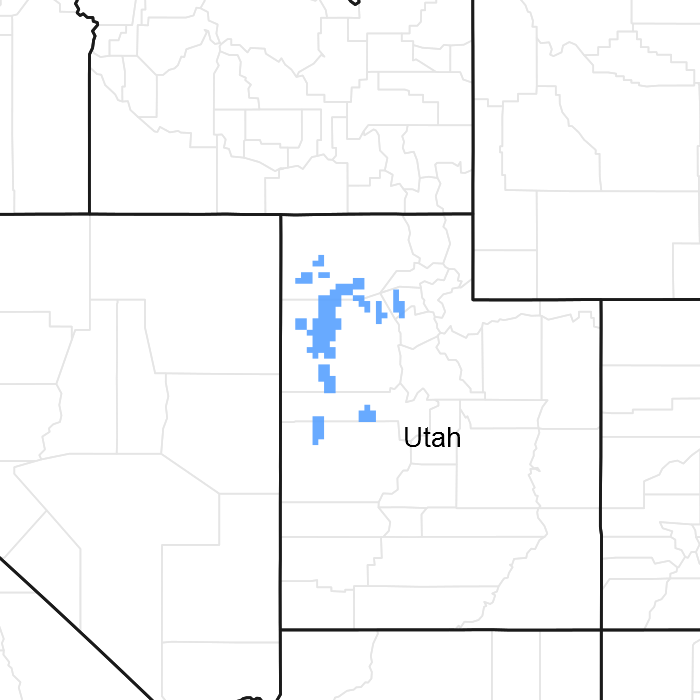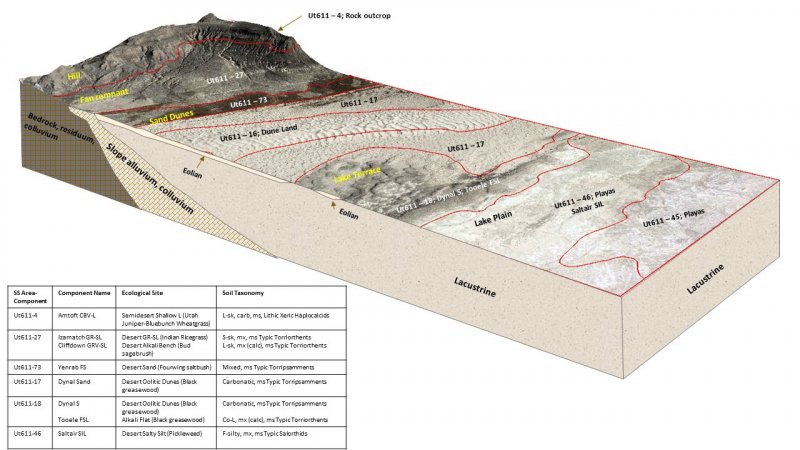Ecological dynamics
As ecological condition deteriorates due to grazing pressure, fourwing saltbush and perennial grasses decrease while greasewood, shrubby seepweed, and annual forbs increase.
When the potential natural plant community is burned, perennial grasses decrease while greasewood, seepweed, and rabbitbrush increase.
This site is similar to Nevada's R028AY024NV ecological site and the STM developed for that site are used (Stringham et. al 2015).
State 1
Reference State
The Reference State 1.0 is a representative of the natural range of variability under pristine conditions. The Reference State has three general community phases; a shrub-grass dominant phase, a perennial grass dominant phase and a shrub dominant phase. State dynamics are maintained by interactions between climatic patterns and disturbance regimes. Negative feedbacks enhance ecosystem resilience and contribute to the stability of the state. These include the presence of all
structural and functional groups, low fine fuel loads, and retention of organic matter and nutrients. Plant community phase changes are primarily driven by fire, periodic long term drought and/or insect or disease attack.
Community 1.1
Black greasewood/alkali sacaton
The dominant aspect of the plant community is greasewood and fourwing saltbush. The composition by air dry weight is approximately 5 percent perennial grasses, 25 percent forbs, and 70 percent shrubs.
Table 5. Annual production by plant type
| Plant type |
Low
(lb/acre) |
Representative value
(lb/acre) |
High
(lb/acre) |
| Shrub/Vine |
70 |
245 |
350 |
| Forb |
25 |
88 |
125 |
| Grass/Grasslike |
5 |
18 |
25 |
| Total |
100 |
351 |
500 |
Table 6. Ground cover
| Tree foliar cover |
0%
|
| Shrub/vine/liana foliar cover |
10-40%
|
| Grass/grasslike foliar cover |
2-5%
|
| Forb foliar cover |
5-15%
|
| Non-vascular plants |
0%
|
| Biological crusts |
0%
|
| Litter |
0%
|
| Surface fragments >0.25" and <=3" |
0%
|
| Surface fragments >3" |
0%
|
| Bedrock |
0%
|
| Water |
0%
|
| Bare ground |
0%
|
Table 7. Canopy structure (% cover)
| Height Above Ground (ft) |
Tree |
Shrub/Vine |
Grass/
Grasslike |
Forb |
| <0.5 |
– |
– |
– |
– |
| >0.5 <= 1 |
– |
– |
– |
10-20% |
| >1 <= 2 |
– |
– |
0-10% |
– |
| >2 <= 4.5 |
– |
35-45% |
– |
– |
| >4.5 <= 13 |
– |
– |
– |
– |
| >13 <= 40 |
– |
– |
– |
– |
| >40 <= 80 |
– |
– |
– |
– |
| >80 <= 120 |
– |
– |
– |
– |
| >120 |
– |
– |
– |
– |
| Jan |
Feb |
Mar |
Apr |
May |
Jun |
Jul |
Aug |
Sep |
Oct |
Nov |
Dec |
| J |
F |
M |
A |
M |
J |
J |
A |
S |
O |
N |
D |
Community 1.2
Alkali sacaton/saltgrass/other perennial grasses
This community phase is characteristic of a post-disturbance, early-seral community phase. Basin wildrye and alkali sacaton dominate the community. Black greasewood will decrease but will likely sprout and return to pre-burn levels within a few years. Early colonizers such as rabbitbrush and shadscale may increase.
Community 1.3
Black greasewood/shadscale/perennial grasses
Black greasewood and shadscale increase in the absence of disturbance. Decadent shrubs dominate the overstory and deep-rooted perennial bunchgrasses in the understory are reduced either from competition with shrubs, herbivory, drought or combinations of these.
Pathway 1.1a
Community 1.1 to 1.2
A low severity fire would decrease the overstory of black greasewood and allow for the understory perennial grasses to increase. Fires are typically low severity resulting in a mosaic pattern due to low fuel loads. A fire following an unusually wet spring facilitating an increase in fine fuels may be more severe and reduce black greasewood cover to trace amounts.
Pathway 1.1b
Community 1.1 to 1.3
Absence of disturbance over time, significant herbivory, long term drought or combinations of these would allow the black greasewood overstory to increase and dominate the site. This will generally cause a reduction in perennial bunchgrasses; however inland saltgrass may increase in the understory depending on the timing and intensity of herbivory. Heavy spring utilization will favor an increase in black greasewood.
Pathway 1.2a
Community 1.2 to 1.1
Time and lack of disturbance will allow shrubs to increase
Pathway 1.3a
Community 1.3 to 1.2
Fire will decrease the overstory of black greasewood and allow for the perennial bunchgrasses to dominate the site. Fires will typically by high intensity in this phase due to the dominance of greasewood resulting in removal of the overstory shrub community.
State 2
Current Potential State
This state is similar to the Reference State 1.0 with three similar community phases. Ecological function has not changed, however the resiliency of the state has been reduced by the presence of invasive weeds. Non-natives may increase in abundance but will not become dominant within this State. These non-natives can be highly flammable and can promote fire where historically fire had been infrequent. Negative feedbacks enhance ecosystem resilience and contribute to the stability of the state. These feedbacks include the presence of all structural and functional groups, low fine fuel loads, and retention of organic matter and nutrients. Positive feedbacks decrease ecosystem resilience and stability of the state. These include the non-natives’ high seed output, persistent seed bank, rapid growth rate, ability to cross pollinate, and adaptations for seed dispersal.
Community 2.1
Black greasewood/alkali sacaton
This community phase is similar to the Reference State Community Phase 1.1. This community is dominated by black greasewood. Shadscale and rubber rabbitbrush are also common. The herbaceous understory is dominated by alkali sacaton, inland saltgrass, basin wildrye and other perennial grasses are also common. Non-native annual species such as halogeton, Russian thistle and cheatgrass are present.
Community 2.2
Perennial grasses dominate
This community phase is characteristic of a post-disturbance, early-seral community where annual non-native species are present. Perennial bunchgrasses such as alkali sacaton, inland saltgrass and basin wildrye dominate the site. Depending on fire severity patches of intact shrubs may remain. Black greasewood and rabbitbrush may be sprouting. Annual non-native species are stable to increasing in the community.
Community 2.3
Shrub/saltgrass
Black greasewood dominates the overstory and perennial bunchgrasses in the understory are reduced, either from competition with shrubs or from inappropriate grazing, or from both. Rabbitbrush may be a significant component. Annual non-native species are stable or increasing. This community is at risk of crossing a threshold to State 3.0 (grazing or fire).
Pathway 2.1a
Community 2.1 to 2.2
A low severity fire would decrease the overstory of black greasewood and allow for the understory perennial grasses to increase. Fires are typically low severity resulting in a mosaic pattern due to low fuel loads. A fire following an unusually wet spring or a change in management favoring an increase in fine fuels may be more severe and reduce black greasewood cover to trace amounts. Brush treatments with minimal soil disturbance may also reduce black greasewood and allow for perennial bunchgrasses to increase. Annual non-native species are likely to increase after fire.
Pathway 2.1b
Community 2.1 to 2.3
Absence of disturbance over time, chronic drought, inappropriate grazing management or combinations of these would allow the black greasewood overstory to increase and dominate the site. Inappropriate grazing management reduces the perennial bunchgrass understory; conversely inland saltgrass may increase in the understory.
Pathway 2.2a
Community 2.2 to 2.1
Absence of disturbance over time and/or grazing management that favors the establishment and growth of black greasewood allows the shrub component to recover.
Pathway 2.3b
Community 2.3 to 2.1
Fire would reduce shrubs in the overstory and allow for the perennial bunchgrasses in the understory to increase.
Pathway 2.3a
Community 2.3 to 2.2
Grazing management that reduces shrubs will allow for the perennial bunchgrasses in the understory to increase. Heavy late-fall/winter grazing may cause mechanical damage to black greasewood promoting the perennial bunchgrass understory. Brush treatments with minimal soil disturbance will also decrease black greasewood and release the perennial understory. Annual non-native species are present and may increase in the community. A low severity fire would decrease the overstory of black greasewood and allow for the understory perennial grasses to increase.
State 3
Shrub State
This state has two community phases, one that is characterized by a dominance of a black greasewood overstory and the other with a rabbitbrush overstory. This site has crossed a biotic and abiotic threshold and site processes are being controlled by shrubs. Bare ground has increased and pedestalling of grasses may be excessive.
Community 3.1
Shrubs/annual non-native species
Black greasewood dominates the overstory. Rabbitbrush may be a significant component. Deep-rooted perennial bunchgrasses such as alkali sacaton have significantly declined. Annual non-native species increase. Bare ground is significant.
Community 3.2
Rabbitbrush/annual non-native species
Rabbitbrush dominates the site. Perennial bunchgrasses may be present but will be a minor component. Annual non-native species are present and may be increasing in the understory.
Pathway 3.1a
Community 3.1 to 3.2
Drought and/or lowering of water table by groundwater pumping would reduce black greasewood and allow for rabbitbrush and other shrubs on the site to dominate. Severe fire would also reduce black greasewood overstory and allow for an increase rabbitbrush.
Pathway 3.2a
Community 3.2 to 3.1
Release from drought and/or grazing pressure may allow for black greasewood, basin wildrye and other perennial bunchgrasses to increase.
Transition T1A
State 1 to 2
Trigger: This transition is caused by the introduction of non-native annual plants, such as cheatgrass, mustards, halogeton, and Russian thistle.
Slow variables: Over time the annual non-native species will increase within the community.
Threshold: Any amount of introduced non-native species causes an immediate decrease in the
resilience of the site. Annual non-native species cannot be easily removed from the system and have the potential to significantly alter disturbance regimes from their historic range of variation.
Transition T2A
State 2 to 3
Trigger: To Community Phase 3.1: Inappropriate cattle/horse grazing will decrease or eliminate deep rooted perennial bunchgrasses and favor shrub growth and establishment. To Community Phase 3.2: Severe fire will reduce and/or eliminate black greasewood overstory and decrease perennial bunchgrasses. Soil disturbing brush treatments will reduce black greasewood and possibly increase non-native annual species. Lowering of the water table due to groundwater pumping will also decrease black greasewood and allow for rabbitbrush and other shrubs to increase.
Slow variables: Long term decrease in deep-rooted perennial bunchgrasses density and/or black greasewood.
Threshold: Loss of deep-rooted perennial bunchgrasses changes nutrient cycling, nutrient redistribution, and reduces soil organic matter. Loss of long-lived, black greasewood changes the temporal and depending on the replacement shrub, the spatial distribution of nutrient cycling.


